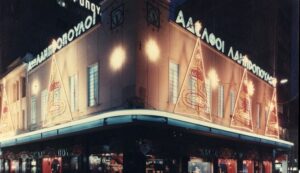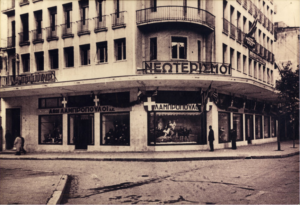Although the name “Lambropoulos Bros” no longer exists, it remains alive in our memories, revived by a new photo album.
Many, especially those over 40, may associate Lambropoulos Bros with being the competitor to Minion or, at best, a part of the combined Christmas shopping stroll in central Athens, where we would leave with a gift from St. Nicholas. However, Lambropoulos Bros has a much larger, lesser-known history and a significant impact on the local economy. This legacy spans 100 years, extending beyond department stores into production (such as Kolynos, which became synonymous with Greece), the music industry with the creation of Columbia, and even sports. All of this is encapsulated in the album “Lambropoulos Bros 1901 – 1999” by the Demetrius & Blanche Lambropoulos Philanthropic Foundation.
The story begins in the late 19th century in the mountain village of Kontovazaina, Arcadia, where Panagiotis Lambropoulos opened the only grocery store. His son, Xenofon, moved to Athens in the early 20th century, starting as a peddler selling men’s goods.

During the Occupation
It is difficult to fully describe the vast activities of the Lampropouloi Group and its members over 100 years in a single text, but much of this is captured in a photo album by the exclusive photographer of Columbia, Panos Pananidis. He referred to Lambropoulos Bros as a “legendary dynasty”:
“Xenofon, the pioneer; Themistoklis, the creator of Greek phonographs; Konstantinos, the theorist; Vasilis, the aristocrat; Mhtsos, the joker; and Theodoros, the mild-mannered… The three Takis shared the following duties: Mr. Takis X. (son of Xenofon, the eldest and creator of the dynasty), visionary with numerous strategic suggestions and a good economist, first president of SELPE and member of the board of the National Bank, took over as general manager of all commercial stores and examiner for hiring. No ‘uncle from Koroni’ or from Kontovazaina would pass through there… The letters from prime ministers, ministers, and the Royal Palace for the recruitment of acquaintances were thrown into the trash if the applicants didn’t meet the qualifications!”
During the Occupation, the company decided to support its civil servant clientele by selling products at pre-war prices and providing food assistance to its employees.
On February 28, 1942, during the Occupation, the company’s stores on Stadiou Street and the corner of Aiolou and Sofokleous were requisitioned by the Occupying forces. Fearing bombings, the company stored its goods in a warehouse in Kolaitso Square, which was later looted during the December events. After the Civil War, the company found itself without capital and merchandise to distribute. Slowly, with products from Greek suppliers due to currency restrictions, the company began to return to normalcy. By 1951, the company celebrated its 50th anniversary amidst rapid growth tied to the urbanization of the Greek population.

The Great Rise
The 1960s saw Lambropoulos Bros’s expansion as Athens’ population grew from 1.4 million in the mid-1950s to 2.5 million. In 1960, the company focused its marketing campaign on women, believing they were the ones buying for the whole family. The company’s commercial strategy was based on: “Prices absolutely fixed – Small profit – Large consumption.”
A major turning point occurred in December 1965 with the opening of the new building on Lycurgus Street 6, with a total area of 6,500 m² designed by architect Solon Kydoniatis. This building introduced several innovations in Greece, such as a temperature-controlled air barrier at the entrance, air conditioning, and automatic fire extinguishing systems.

The 1970s’ Challenges
The issue of store operating hours became a major topic in the late 1970s. According to the company’s General Assembly records, “the matter of store hours, crucial for commercial development, has not been solved.” In 1978, the company faced an increase in thefts, leading to the hiring of former experienced saleswomen to patrol stores during peak hours posing as customers to catch thieves.
In 1979, other challenges arose as consumers began to spend more on entertainment than on shopping, and the store hours remained unaligned with European and global standards, further hindering the customer base.

From Arson to the End of an Era
In October 1979, a new store opened in Piraeus with 100 employees. However, following a series of arson attacks on department stores in Athens, Lambropoulos Bros’s Piraeus store was set on fire on July 7, 1981. The store was forced to transfer its employees to the Athens store, which was protected by guards when closed. The damage was done, as customers began avoiding downtown shopping centers due to the fear of arson. For years, the company reported declining sales and losses.
In the following years, Lambropoulos Bros faced competition from the state-owned Minion, which operated under less restrictive financial terms, as well as the introduction of VAT and declining consumer purchasing power. Nevertheless, the company continued to expand with new stores, which would later contribute to the creation of the Notos Galleries retail chain.
Though Lambropoulos Bros ultimately withdrew from the retail sector, its legacy continues through the Dimitrios & Blanche Lambropoulos Philanthropic Foundation, which has been helping thousands of people and institutions since 1977. To date, the foundation has donated millions of euros for charitable purposes and provided support to over 3,500 families and 100 charitable organizations.
Source : News247






